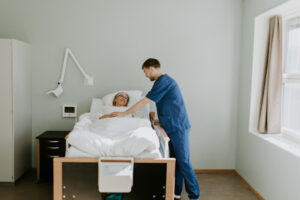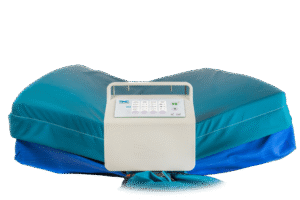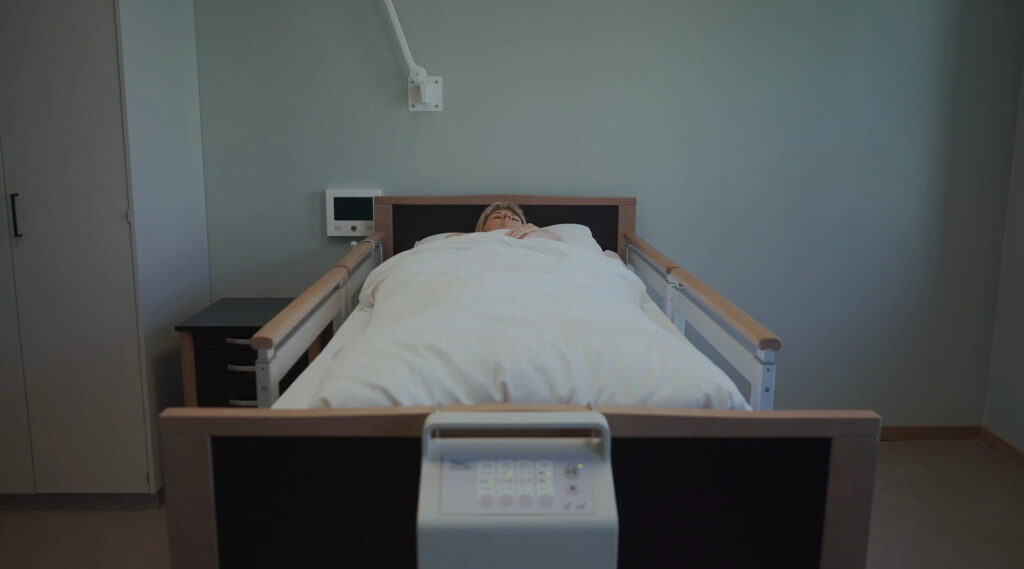For people with reduced mobility, prolonged bed rest, or a high risk of pressure ulcers, the right mattress choice is essential. In the healthcare system, pressure-relieving mattresses and turning mattresses are often used as part of the measures to prevent and treat pressure ulcers – but what distinguishes these mattresses in practice, and what are their limitations?
In this article, we take a closer look at the differences, advantages and weaknesses of these mattresses in a medical context – and introduce an alternative: Tidewave – a mattress that is always on the move.
Pressure-relieving mattress – distribution of pressure using foam or air
A pressure-relieving mattress is designed to reduce the pressure points on the body by distributing the body weight as evenly as possible. This is especially important for people who lie in the same position for a long time, as constant pressure against bone protrusions can lead to pressure ulcers.
Types of pressure-relieving mattresses:
-
Static foam mattresses: Memory foam or viscoelastic foam that moulds to the body
-
Dynamic air mattresses: Alternating pressure systems with air cells that are filled and deflated at intervals
-
Hybrid mattresses: Combines foam and alternating pressure for increased comfort and function
Advantages in medicinal use:
-
Reduces pressure on exposed areas such as lower back, heels shoulders
Limitations:
-
Often requires combination with manual repositioning of caregivers
-
Dynamic mattresses can disturb sleep due to noise and sudden movements
-
Can be challenging for patients with cognitive impairment or anxiety
Turning mattress – motorised aid for automatic turning
A turning mattress is a type of motorized aid designed to reposition people who are unable to turn themselves in bed. Unlike traditional mattresses that have to be turned manually, the turning mattress offers a form of automatic side turning using air chambers or mechanical solutions. It is designed specifically for patients at high risk of pressure ulcers and who are fully or partially immobile.
Typical use:
-
In nursing homes and home-based care where the patient is bedridden
-
For patients at moderate to high risk of pressure ulcers
-
As relief for nursing staff in repositioning work
Advantages:
-
Provides automated turning at fixed intervals
-
Reduces the need for manual turning around the clock
-
Can be combined with a pressure-relieving mattress topper or air system
Limitations:
-
Many models have few options for adjusting movement
-
Some models cannot guarantee correct and comfortable lying position
-
Not all models adapt to the patient’s natural movement pattern
-
Some systems may be noisy or unsettling during sleep
Repositioning – a critical measure to prevent pressure ulcers
Regardless of the mattress type , repetitive repositioning is a key part of pressure ulcer prevention. Health authorities recommend that patients who cannot turn around on their own, repositioned every 2 hours – around the clock. This requires considerable effort from healthcare personnel and relatives, and is both physically demanding and resource-intensive.
Neither pressure-relieving nor turning mattresses solve this need all by themselves – most must always be combined with manual moving or turning of the patient.

Tidewave – the next generation mattress for a stable lying position and continuous movement
Tidewave is a mattress developed specifically for patients with reduced mobility and who need a long-term lying position. Unlike traditional mattresses, Tidewave automatically repositions the user throughout the night, by moving gently from side to side.
How does Tidewave work?
- Curves to the body for a stable lying position throughout the movement
-
Moves the body slowly and smoothly from side to side – mimicking natural movements
-
Eliminates the need for manual repositioning, but without waking the patient
-
Continuous pressure distribution without interruption of sleep
Advantages with Tidewave:
-
Eliminates the need for manual repositioning
-
Prevents pressure ulcers more effectively than static solutions
-
Reduces the burden on healthcare personnel and relatives
-
Quiet and comfortable – improves sleep quality
-
Used in home care services, nursing homes and private homes
Clinical results:
Tidewave is CE-marked medical equipment and is used by several Norwegian municipalities and hospitals. Feedback shows:
-
Reduction in pressure ulcers
-
Better rest and recovery for patients
-
Less wear and tear and sick leave among nursing staff

Conclusion
While pressure-relieving mattresses and turning mattresses can be useful aids in some situations, they have clear limitations when it comes to effective pressure ulcer prevention – especially for patients who cannot move on their own.
Tidewave represents a new standard in medical mattresses, by combining active repositioning with patient comfort, documented efficacy and relief for healthcare professionals. For people at high risk of pressure ulcers, or who already rely on manual turning, Tidewave is a better, safer, and more sustainable choice. Read more about it here.
